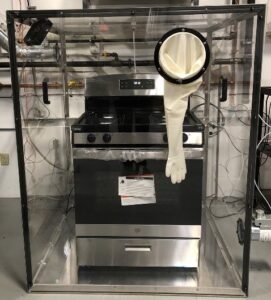Range Natural Gas Emissions Study
Primaira worked closely with Eta Partners to investigate the levels of natural gas that are emitted by stoves and ovens. Numerous studies suggest that some amount of natural gas is released into the home by ranges. The exact mechanisms of why this is have not been clearly determined. Our goal was to characterize gas emissions from ranges and provide insight to our partners and their clients.
We approached the problem by measuring the concentration of methane released by ranges after various use cases. The concentration of methane in natural gas is typically greater than 90%.1 Because of this, methane serves as a useful flag for detecting natural gas leaks.

Figure 1: Air-Tight Testing Chamber
Primaira utilized its gas testing expertise to conduct a comprehensive and accurate study. Our engineers constructed a custom chamber that encloses a range in an airtight space. The chamber allows for easy range installation, inline flow rate measurements, and precision air sampling. Our researchers used the chamber to interact with various range models and take air samples for analysis. They then measured precisely how much methane was present in a sample with our gas chromatography instruments. We then analyzed the data to provide useful summaries to our partners.
Our team conducted various tests to isolate where emissions of natural gas were coming from. We studied emissions from burner ignition, burner extinguishing, and steady state leakage. We also performed user studies to characterize how people interface with ranges. Different range brands including Samsung, GE, and Premier were tested. We looked at both newer and older models and made comparisons between higher and lower cost products.
1. We reference data from the Tennessee Gas Pipeline Company to determine the live composition of our gas.
